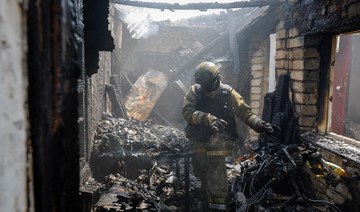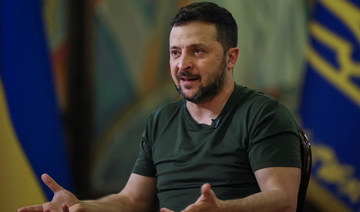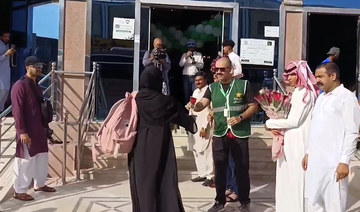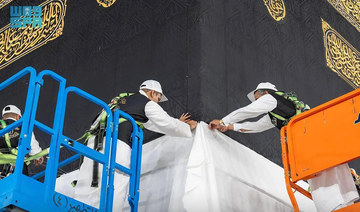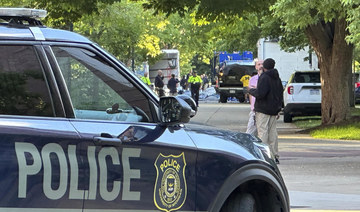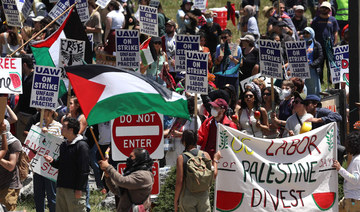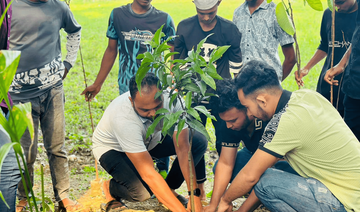BRUSSELS: European Union leaders concluded a controversial deal with Turkey on Friday intended to halt illegal migration flows to Europe in return for financial and political rewards for Ankara.
The accord aims to close the main route over which a million migrants and refugees poured across the Aegean Sea to Greece before marching north to Germany and Sweden in the last year. But deep doubts remain about whether it is legal or workable.
After a morning of talks with Turkish Prime Minister Ahmet Davutoglu, European Council President Donald Tusk recommended that the 28 EU member states approve the text without changes and they rapidly agreed at a summit lunch in Brussels.
“Agreement with Turkey approved. All illegal migrants who arrive to Greece from Turkey starting March 20 will be returned!” Czech Prime Minister Bohuslav Sobotka tweeted, before Tusk confirmed unanimous agreement among the EU and Turkey.
Under the pact, Ankara would take back all illegal migrants who cross to Greece, including Syrians, in return for the EU taking in thousands of Syrian refugees directly from Turkey and rewarding it with more money, early visa-free travel and progress in its EU membership negotiations.
The EU also agreed to accelerate disbursement of 3 billion euros already pledged in support for refugees in Turkey and to provide a further 3 billion by 2018 once Ankara came up with a list of projects that qualified for EU assistance.
In Turkey, President Recep Tayyip Erdogan blasted several EU states for taking only a “handful of refugees” in contrast to the nearly three million Turkey has admitted, most of them fleeing the Syrian war.
He also accused the Europeans of supporting the outlawed Kurdistan Workers’ Party (PKK) days after a bombing in Ankara claimed by Kurdish rebels that killed 35 people, and warned they faced similar attacks.
“European countries are paying no attention, as if they are dancing in a minefield,” he said.
Despite the tough talk there were signs of progress, as Tusk later called a meeting of all 28 EU leaders to update them on his talks with Davutoglu before the Turkish premier met with his counterparts, Tusk’s spokesman said.
EU, Turkey clinch deal to send back migrants
EU, Turkey clinch deal to send back migrants

Russia says main power line to Zaporizhzhia nuclear plant goes down, no safety threats
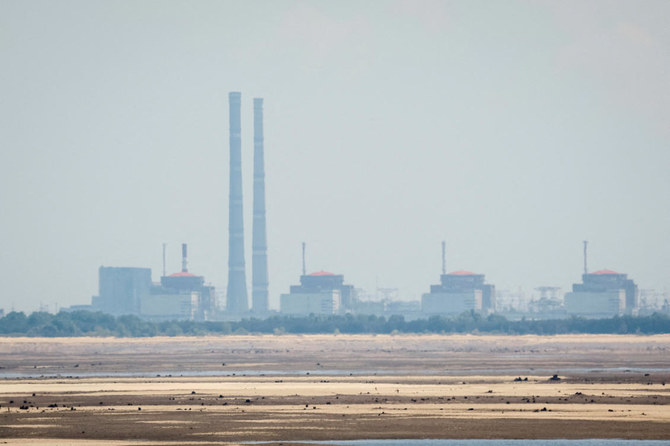
The main 750 kilovolt (kV) “Dniprovska” power line went down at 13.31 local
MOSCOW: Russia said on Thursday that the main power line supplying the Russian-controlled Zaporizhzhia nuclear power plant (ZNPP) in Ukraine had gone down, but that there was no threat to safety and the plant was being supplied via a backup line.
The six reactors at the Zaporizhzhia plant, held by Russia and located close to the front line of the conflict in Ukraine, are not in operation but it relies on external power to keep its nuclear material cool and prevent a catastrophic accident.
The Russian management said on their official channel on the Telegram app that the reasons for the outage, which had not caused any change in the radiation level, were being investigated.
It said the main 750 kilovolt (kV) “Dniprovska” power line went down at 13.31 local (1031 GMT), while the 330 kV “Ferosplavnaya” line was supplying power to the plant now.
The main “Dniprovska” power line also went down for almost five hours on March 22, highlighting what the International Atomic Energy Agency (IAEA) said were “ever present dangers to nuclear safety and security” from the Russia-Ukraine war.
Russia and Ukraine have each accused the other at various times of shelling the Zaporizhzhia plant, which is Europe’s largest.
IAEA has said that the ZNPP has been experiencing major off-site power problems since the conflict began in early 2022, exacerbating the nuclear safety and security risks facing the site.
US will announce $275 million more in artillery and ammunition for Ukraine, officials say
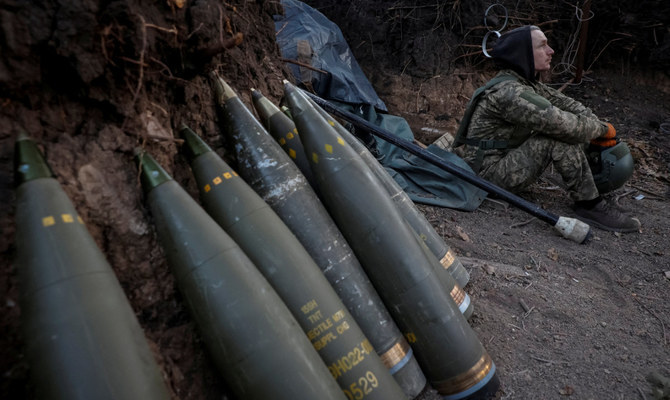
- This will be the fourth installment of military aid for Ukraine since Congress passed a long-delayed foreign aid bill late last month
- Russia has sought to take advantage of Ukrainian shortages in manpower and weapons while the war-torn country waits for the arrival of more US assistance
WASHINGTON: The United States is expected to announce an additional $275 million in military aid for Ukraine on Friday as Kyiv struggles to hold off advances by Russian troops in the Kharkiv region, two US officials say.
This will be the fourth installment of military aid for Ukraine since Congress passed a long-delayed foreign aid bill late last month and comes as the Biden administration has pledged to keep weapons flowing regularly and to get them to the front lines as quickly as possible.
The package includes high mobility artillery rocket systems, or HIMARS, as well 155 mm and 105 mm high-demand artillery rounds, according to the two US officials. They spoke on the condition of anonymity to provide details of the aid package before the public announcement.
It follows a monthly gathering Monday of about 50 defense leaders from Europe and elsewhere who meet regularly to coordinate getting more military aid to Ukraine. At this latest meeting, Defense Secretary Lloyd Austin said Ukraine was in a “moment of challenge” due to Russia’s new onslaught on Kharkiv, Ukraine’s second-largest city. He pledged to keep weapons moving “week after week.”
Russia has sought to take advantage of Ukrainian shortages in manpower and weapons while the war-torn country waits for the arrival of more US assistance, which was delayed for months in Congress. Ukrainian forces have been pushed backward in places, while Russia has pounded its power grid and civilian areas.
In the month since President Joe Biden signed the $95 billion foreign aid package, which included about $61 billion for Ukraine, the US has announced and started to send almost $1.7 billion in weapons pulled from Pentagon stockpiles.
It’s also announced $6 billion in funding through the Ukraine Security Assistance Initiative. That pays for longer-term contracts with the defense industry and means that the weapons could take many months or years to arrive.
With this latest package, the US has now provided almost $51 billion in military assistance to Ukraine since Russia invaded in February 2022.
First pilgrims from Philippines depart for Hajj 2024
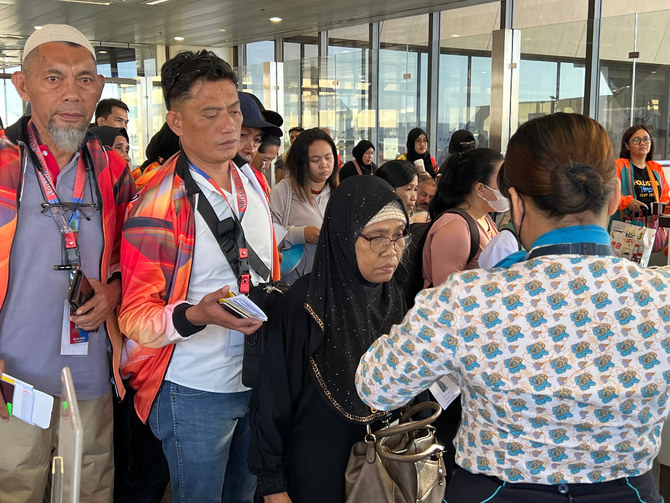
- About 5,000 Filipino Muslims are set to perform Hajj this year
- Muslims make up 10 percent of majority Catholic Philippine population
MANILA: The National Commission on Muslim Filipinos sent off the first group of Hajj pilgrims on Thursday, marking the beginning of the annual pilgrimage season for Muslims from the predominantly Catholic Philippines.
Muslims constitute about 10 percent of the nearly 120 million Philippine population, with most living on the island of Mindanao and the Sulu archipelago in the country’s south, as well as in the central-western province of Palawan.
With the Hajj this year expected to start on June 14 and end on June 19, many pilgrims depart early to make the most of the spiritual journey that is one of the five pillars of Islam.
The Philippines’ first group of 150 pilgrims left early on Thursday morning from the main airport in Manila, making the first leg of their journey to Madinah via Oman.
“The Hajj is not merely a journey undertaken for personal fulfillment, it is a profound act of devotion symbolizing unity, equality and submission to the will of the Almighty Allah,” NCMF Secretary Sabuddin Abdurahim said during the sendoff ceremony.
NCMF is the body governing Muslim affairs in the Philippines, in charge of organizing the annual Hajj pilgrimage.
“As we bid farewell to our beloved pilgrims embarking on the sacred journey to Saudi Arabia for Hajj, my heart is filled with prayers for your safety, security and the smoothest of journeys,” Abdurahim said.
“I fervently pray that this year’s Hajj is free from any hurdles of challenges, ensuring a profound spiritual experience for each of you.”
About 5,000 Muslims have confirmed their travel to Saudi Arabia for the pilgrimage this year, the NCMF said.
Hapidz Yusop, a pilgrim from Sulu, said that he was fulfilling his dream of doing the sacred pilgrimage.
“It’s been my lifelong dream. I’ve been planning to do the Hajj for a long time, but I don’t have the means, I don’t have the money. But by the mercy of God and the help of our mayor in Talipao, I’m finally here,” he told Arab News, referring to how his arrangements for Hajj were sponsored by the local government in Talipao.
“It feels like we are born again, that we will be cleansed of all of our sins and be born again. May God give us mercy,” Yusop said.
Rahyan Tulawi Amaraja, a 30-year-old nurse from Sulu’s Jolo island, will embark on this year’s Hajj with her parents.
“It has been my aspiration since I was a child to perform my pilgrimage. Fortunately, I will perform my Hajj journey with my parents, which is one of my aspirations, too,” she told Arab News.
“I am overwhelmed with joy,” she said. “For this Hajj journey, I wish to have Allah’s mercy and forgiveness, and to be able to perform it well and successfully.”
Pro-Palestinian protesters leave after Drexel University decides to have police clear encampment
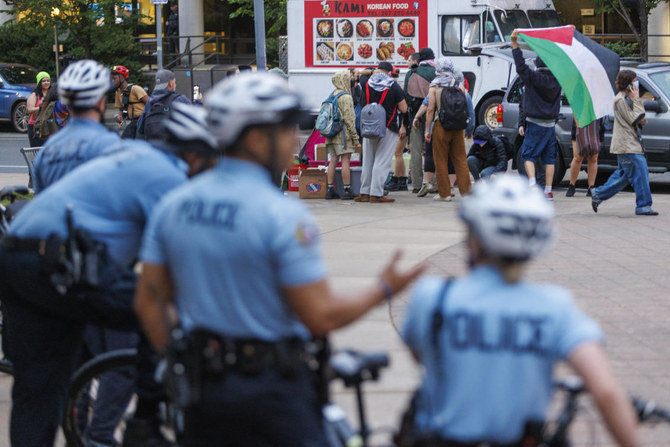
- News outlets reported that police gave protesters a warning to clear the encampment and protesters left
- “An unauthorized encampment that involves large numbers of people unaffiliated with Drexel trespassing on our campus is illegal,” Fry said
PHILADELPHIA: Protesters packed up their belongings and left a pro-Palestinian encampment at Drexel University on Thursday after the school announced a decision to have police clear the encampment.
University President John Fry said in a statement that he decided to have campus police and public safety officers join Philadelphia police in clearing the encampment as peacefully as possible.
News outlets reported that police gave protesters a warning to clear the encampment and protesters left. Protesters didn’t immediately comment.
Fry said the university is committed to protecting the community members’ right to assemble peacefully and express their views, but he has the responsibility and authority to regulate campus gatherings to ensure safety and fulfill the mission to educate students.
“An unauthorized encampment that involves large numbers of people unaffiliated with Drexel trespassing on our campus is illegal,” Fry said. “The language and chants coming from this demonstration, underscored by protesters’ repugnant ‘demands,’ must now come to an end.”
Protesters gathered their belongings as dozens of officers on bicycles arrived around 5:20 a.m., but in less than a half hour only a few items remained on the Korman Family Quad where the 35-tent encampment had been, the Philadelphia Inquirer reported.
“The campers picked up their belongings for the most part and left by their own free will,” Philadelphia Police Sgt. Eric Gripp said.
The encampment had persisted despite Fry’s threat earlier this week to have the encampment cleared. Fry said Tuesday that classes would be held virtually for a third day on Wednesday after administrators tried to open a line of communication to the protesters but were rebuffed. News outlets reported that the university announced Wednesday night that the campus would return to normal operations Thursday.
In his statement early Thursday, Fry said previous requests for protesters to disperse had been ignored, but he was asking Drexel affiliates to leave the encampment so police could “escort any remaining trespassers off our campus.”
A wave of pro-Palestinian tent encampments on campuses has led to over 3,000 arrests nationwide.
On Thursday, the leaders of Northwestern University and Rutgers University are expected to testify at a House Committee on Education and the Workforce hearing about concessions they gave to pro-Palestinian protesters to end demonstrations on their campus. The chancellor of the University of California, Los Angeles, also was scheduled to appear at the latest in a series of hearings looking into how colleges have responded to the protests and allegations of antisemitism.
Bangladeshi architect’s community-centric work builds resilience to climate change
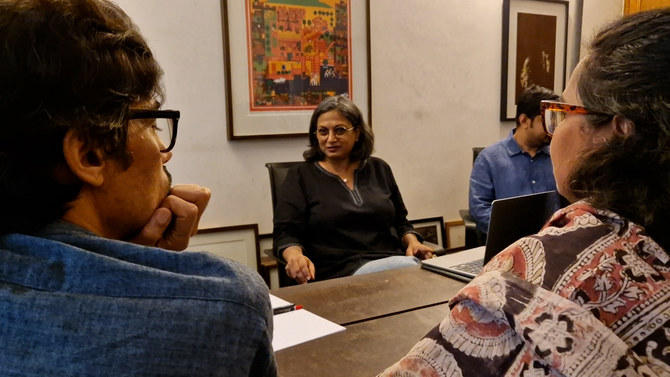
- Marina Tabassum is among Time’s most influential people of 2024
- Her mosque in Dhaka received the 2016 Aga Khan Award for Architecture
DHAKA: With structures that “breathe” and are designed in tune with Bangladesh’s history and environment, Marina Tabassum’s work focuses on the local community and resilience in the country where every year millions of people lose their homes and livelihoods to climate change.
The award-winning founder of Marina Tabassum Architects came to the international spotlight after winning the 2016 Aga Khan Award for Architecture for the Bait Ur Rouf Mosque in Dhaka, which she designed, built and fundraised.
An architect and educator, she is also the recipient of the prestigious 2021 Soane Medal for Architecture, the 2021 Gold Medal by the French Academy of Architecture, the 2021 Arnold W. Bruner Prize from the American Academy of Arts and Letters 2021, and the Lisbon Millennium Lifetime Achievement Award, which she received in 2022.
In 2024, she was featured on Time Magazine’s 100 Most Influential People list for developing a “practice and a way of being that prioritizes local cultures and values, as well as the perils faced by our shared planet.”
One of the drivers of Tabassum’s work is a sense of responsibility.
“There is enormous disparity in our human condition in Bangladesh and I feel like it’s not just my responsibility, (but) it’s for everybody to take that, their own share of the responsibility, and to do something about it,” she told Arab News at her practice in Dhaka.
“And I am of a breed who has the knowledge, has the capacity, all the different things that are required to take the responsibility to reduce these differences.”
Throughout her nearly three-decade career, she has designed some of Bangladesh’s most famous structures, which, besides the Bait Ur Rouf Mosque, are the Museum of Independence in Dhaka — a project with Kashef Chowdhury — as well as housing adapted to the environment, including a modular mobile house for climate victims in the country’s south and north.
The Bait Ur Rouf Mosque, which is personally very close to Tabassum, was built on land donated by her grandmother and with a modest budget raised through community contributions.
“I was not just designing it, but also constructing it, fundraising it, so that became a very intensely involved project. I would say it is an important milestone for me and also it gave me a lot of international acclaim, which definitely helps in many ways,” she said.
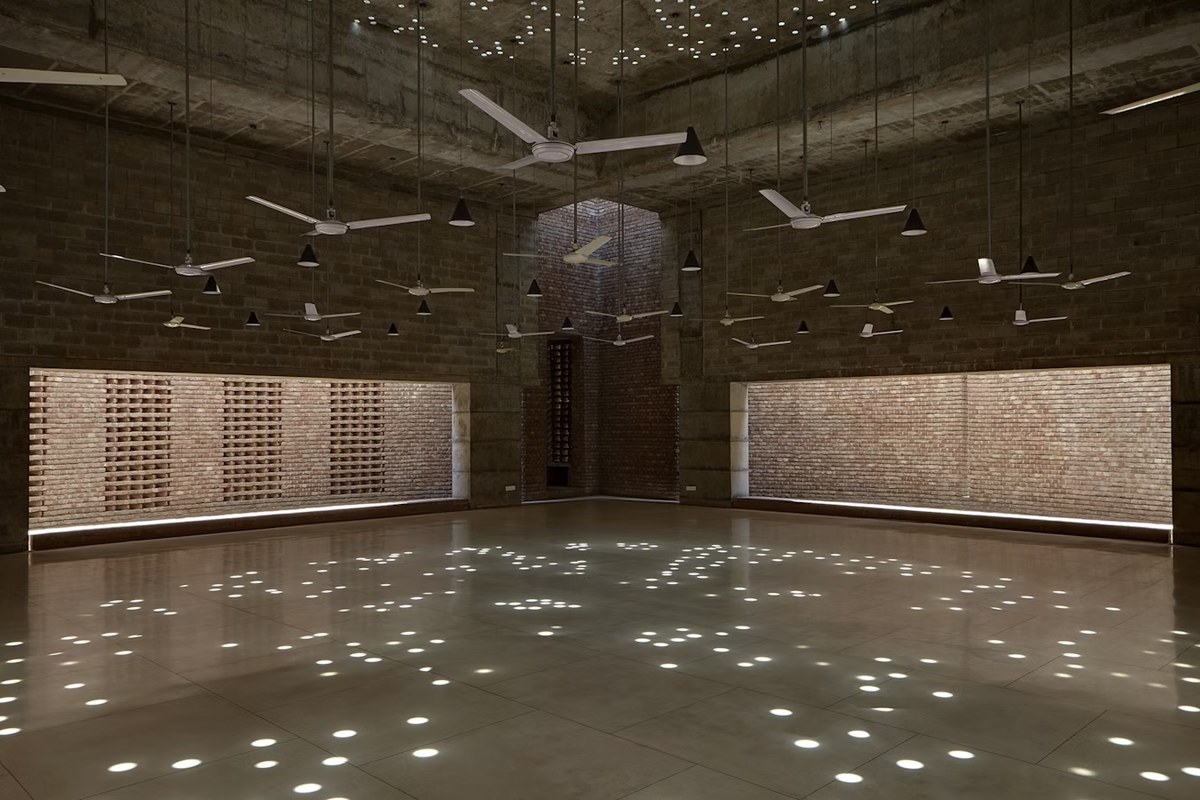
The building’s porous brick walls keep it ventilated and cool while natural light enters it through a skylight. For Tabassum, one of the most important features in her work is that it “has to be able to breathe without artificial aids,” especially in her own subtropical country.
“It’s important for us to have our buildings as open as possible so that we can have natural ventilation, air can come and pass through the buildings. That’s what I call the breathing of a building,” she said.
“That’s an absolutely crucially important phenomenon that we should integrate in our architecture.”
Another crucial factor is having her architecture rooted, as much as possible, in the local context, including by sourcing material locally and working with local craftsmen.
Working with local communities and “trying to make ourselves available to their service,” is the main focus of her projects now — inspired also by her parents and teachers.
“Till date, my father, who is 87 years of age, is still working as a doctor, giving treatment to people who cannot afford cancer therapy. I think that’s embedded in us, to some extent, to have that value of giving,” she said.
As an architect, she has been inspired by many different people — her professors at Bangladesh University of Engineering and Technology and Muzharul Islam, an architect and urban planner who is considered the grand master of modernism in South Asia.
“There’s a lot that I learned from him,” Tabassum said. “He always talked about how we have a small country and a huge population, how the entire country needs to be planned in a proper manner in terms of land use, in terms of housing, food production, and all the other things that a country requires, and every single space should be properly planned and designed — which we are still yet to do.”
In 2020, she established a new non-profit branch of her practice — the Foundation for Architecture Community Equity — dedicated to providing a home and humane living environment to Bangladesh’s low-income, landless, or climate-affected communities.
One of its flagship initiatives is Khudi Bari, which translates to “little house” in Bengali. Under the project, over 50 such bamboo-frame houses have already been built for the coastal communities where seawater regularly claims the land, and for flood-prone communities in the north, where swelling rivers cause catastrophic flooding during the monsoon season.
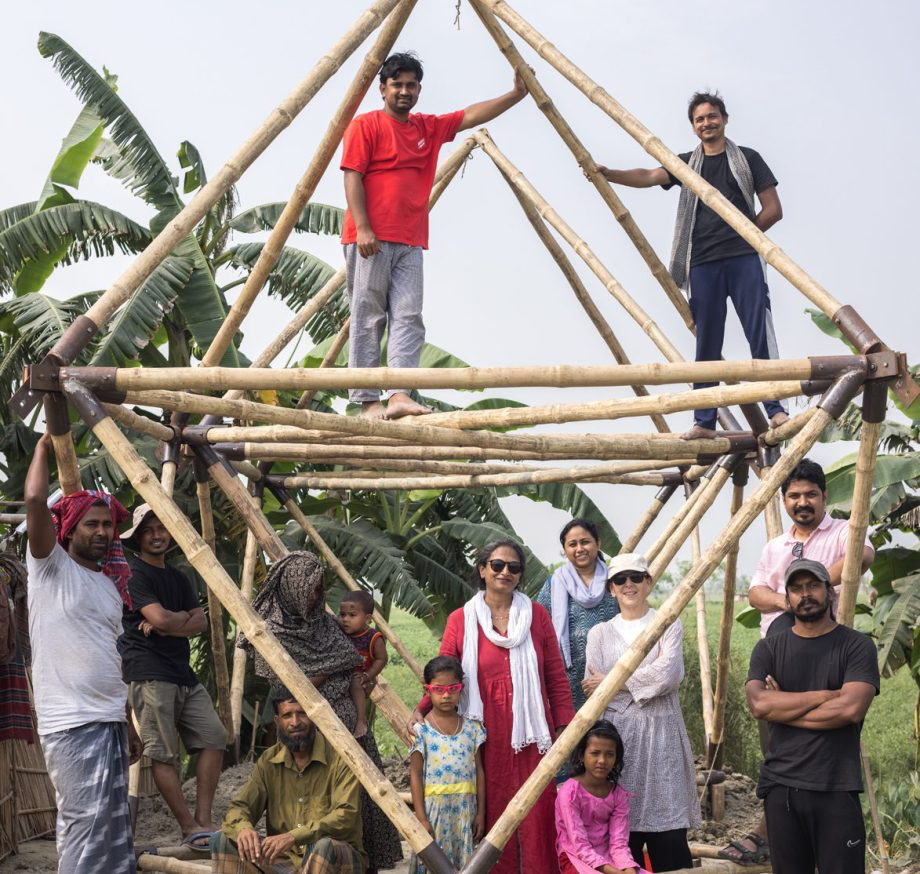
The cheap and light houses are made from materials that are widely available in the regions and are designed to be easily dismantled and moved when needed.
“Architecture is not a product, architecture has expanded and has always had that expanded idea of creating a proper environment, a good environment. And in order to create a good environment, you cannot just focus on a building, but you have to create, starting from planning to landscape to building (according) to people’s living conditions, economics,” Tabassum said.
“It’s about changing the mindset in many ways … The changes I would like to see (are) more about rootedness, more about sourcing locally, building responsibly, including people.”


